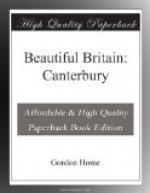There is, however, a material disadvantage suffered by those who use the railway, in that they miss the first view of the Cathedral city set in the midst of soft-swelling eocene hills, which comes as the first stage of the gradual unfolding of the tragic story. The lukewarm pilgrim should therefore remember that he will add vastly to the richness of his impressions if he deserts his train at Selling or Chartham and walks the rest of the way over Harbledown, where he will see the little city of the Middle Ages encircled with its ancient wall and crowned by the towers of its cathedral very much as did the cosmopolitan groups of travel-soiled men and women who for century after century feasted their eyes from the selfsame spot.
[Illustration: Christ church gateway, Canterbury. This beautiful entrance to the Cathedral precincts was built between 1507 and 1517. The richly sculptured stone has weathered exceedingly.]
CHAPTER II
THE STORY OF CANTERBURY
It would be a mistake to imagine that it solely was due to that bloody deed perpetrated on a certain December afternoon back in Norman times that Canterbury occupies a place of such pre-eminence in English history, for the city was ancient before the days of Thomas of Canterbury; and in this short chapter it is the writer’s endeavour to indicate the position of that tragic occurrence in the chronology of the former Kentish capital.
The earliest people who have left evidence of their existence near Canterbury belong to the Palaeolithic Age; but as it is not known whether this remote prehistoric population occupied the actual site, or even whether the valley may not have then been a salt-water creek, it is wiser in this brief sketch to pass over these primitive people and the lake-dwellers who, after a considerable interval, were possibly their successors, and come to the surer ground of history. This brings us to the early Roman invasions of Britain and Julius CA|sar’s description of the people of Kent, whose civilization he found on a higher level than in the other parts he penetrated. He described them as being little different in their manner of living from the Gauls, whose houses were built of planks and willow-branches, roofed with thatch, and were large and circular in form, but he adds:
All the Britons dye themselves with woad, which gives them a bluish colour, and so makes them very dreadful in battle. They have long hair, and shave all the body except the head and upper lip.
These people, owning allegiance to various chiefs and living in camps or villages defended by earthen ramparts, were attacked by the Roman expeditions which invaded Britain in the opening years of the Christian Era, and there is evidence for believing that there was a British settlement of considerable importance on the site of Canterbury. Of this there remains




